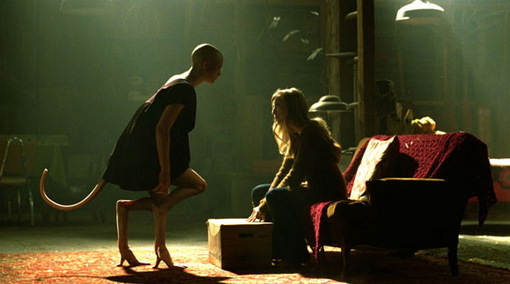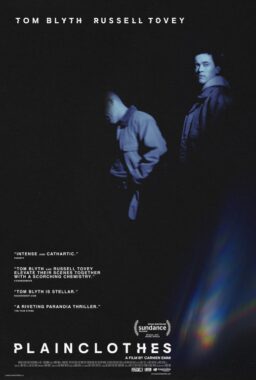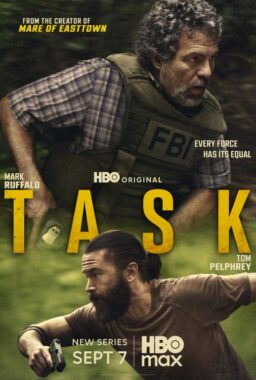“Splice” has the DNA of a really great philosophical horror/science-fiction movie, but in the less-than-fully formed thing that was delivered to theaters, some of its most promising traits remain recessive, under-developed.
You may notice the first sign of this gestational glitch in the otherwise wonderfully gooey in vitro credits sequence, where the title and the names of the lead actors are spelled out in mutant organic forms, like veins bulging beneath the surface of fetal skin. The credits read: “Screenplay by Vincenzo Natali & Antoinette Terry Bryant and Doug Taylor” — which indicates that director Natali worked on it with Bryant, and Taylor was probably either the original writer or did enough of a re-write to merit a screen credit. Someone — or something — almost certainly re-formed the last half-hour of the movie, when it suddenly dies and comes back as the predictable horror clone into which it had successfully avoided mutating up until that point.
You can almost feel the splice at which the erratically paced, action-packed ending to another, lesser scary movie has been grafted onto the genetic horror of this one. It happens right around the time Sarah Polley says something like “What’s happening?” and Adrien Brody (off-screen, looped dialogue?) says, “I don’t know. But she’s dying.” Thank you, Dr. Exposition.
“Splice,” a Canadian production, obviously needed a David Cronenberg to flesh it out and bring it to maturity — and to make all the chromosomal, gestational and birth metaphors I’ve packed into these last four paragraphs come to life. Still, co-writer/director Natali shows an awful lot of potential.
I don’t remember the last time I saw a horror movie that was so smart about its references (not just “Frankenstein” and “King Kong,” but “Alien,” “It’s Alive,” “Rosemary’s Baby,” Cronenberg’s “The Brood,” “The Fly,” “Naked Lunch“…) and that showed me things I’ve never seen before. The zoological imagination of “Avatar” pales in comparison to the laboratory-created mutant life forms presented in “Splice”: the maggoty blobs known as Fred and Ginger, and the ever-developing humanoid her creators call Dren. One reason they work so well is that they inhabit a photorealistic world rather than a fantasy one. They become flesh and blood along with the human characters, a pair of bio-engineers who work and live together: Brody’s Clive (think Colin in James Whale’s “Frankenstein”) and Polly’s Elsa (think Lanchester in Whale’s sequel, “Bride of Frankenstein“). It’s a Whale of a picture in more ways than one, moving from Dr. Frankenstein’s laboratory to a nocturnal Old Dark House deep in the woods.
Dren (I’m not going to explain how they come up with that name) is delivered looking like a long-necked squirmy goose, already plucked and beheaded. Then she (we’ll call her “she” for now) turns into a larger, squirming and skittering incarnation of the skinned rabbit on the kitchen counter in “Repulsion” — mated with the radiator baby in “Eraserhead.” From there she morphs into a Polish movie-poster vision of Sinead O’Connor, sporting the pointed tail many Roman Catholics believed she had long been hiding, and the Manolo Blahnik-deformed legs and feet of a strutting “Sex and the City” scarecrow, but with a more refined fashion sense. (It’s a toss-up as to who is scarier: Dren or Sarah Jessica Parker in full SATC drag. But Dren is a lot sexier.) Finally, she becomes Billy Corgan with fangs and feathers, a Mellon Collie indeed.
And her voice! She makes twittering, gurgling sounds that are almost electronic — like a hummingbird. She is bewitching, charming and terrifying… as growing children often are.
The movie is stuffed with potent and scary ideas — few of which, unfortunately, are quite allowed to come to full term. Clive wants them to have a child of their own, but Elsa prefers the laboratory version. At first, Elsa’s devotion to the offspring leaves Clive with unresolved feelings of jealousy and abandonment, but then he begins to feel protective and even attracted to his own “child.” Meanwhile, Elsa senses a sexual rivalry and becomes increasingly strict with the girl — re-enacting insufficiently explained maternal traumas from her own abusive childhood. And Dren has her own Electra complex to work through… and there’s a motif throughout the film that each stage in one’s development is predicated on the death of the previous incarnation.
All of this is presented in a framework that touches on larger moral, social and technological issues having to do with medical ethics and politics, cloning, genetic research, abortion, corporate-funded science and other sticky wickets.
There’s real intelligence and imagination in “Splice” — enough to make me want to check out Natali’s earlier film, “Cube.” The rushed ending reads far better than it plays on screen (the final draft of the script is available here, if you’re interested in seeing how the last half hour or so is meant to build, one revelation upon the other) — and lacks some of the explanatory post-production dialog that makes it feel like it’s been hurriedly thrown together so it can make an abortive lunge for the coda. The big necessary moments and images in these last few spasmodically assembled scenes aren’t given the chance to register (and resonate) — as if somebody were either afraid of following all the way through with the movie’s psycho-biological implications, or just trying to wrap things up as quickly as possible to keep the 104-minute running time well below two hours. Perhaps the DVD release will find the rhythms the movie needs to properly breathe its final breaths.











